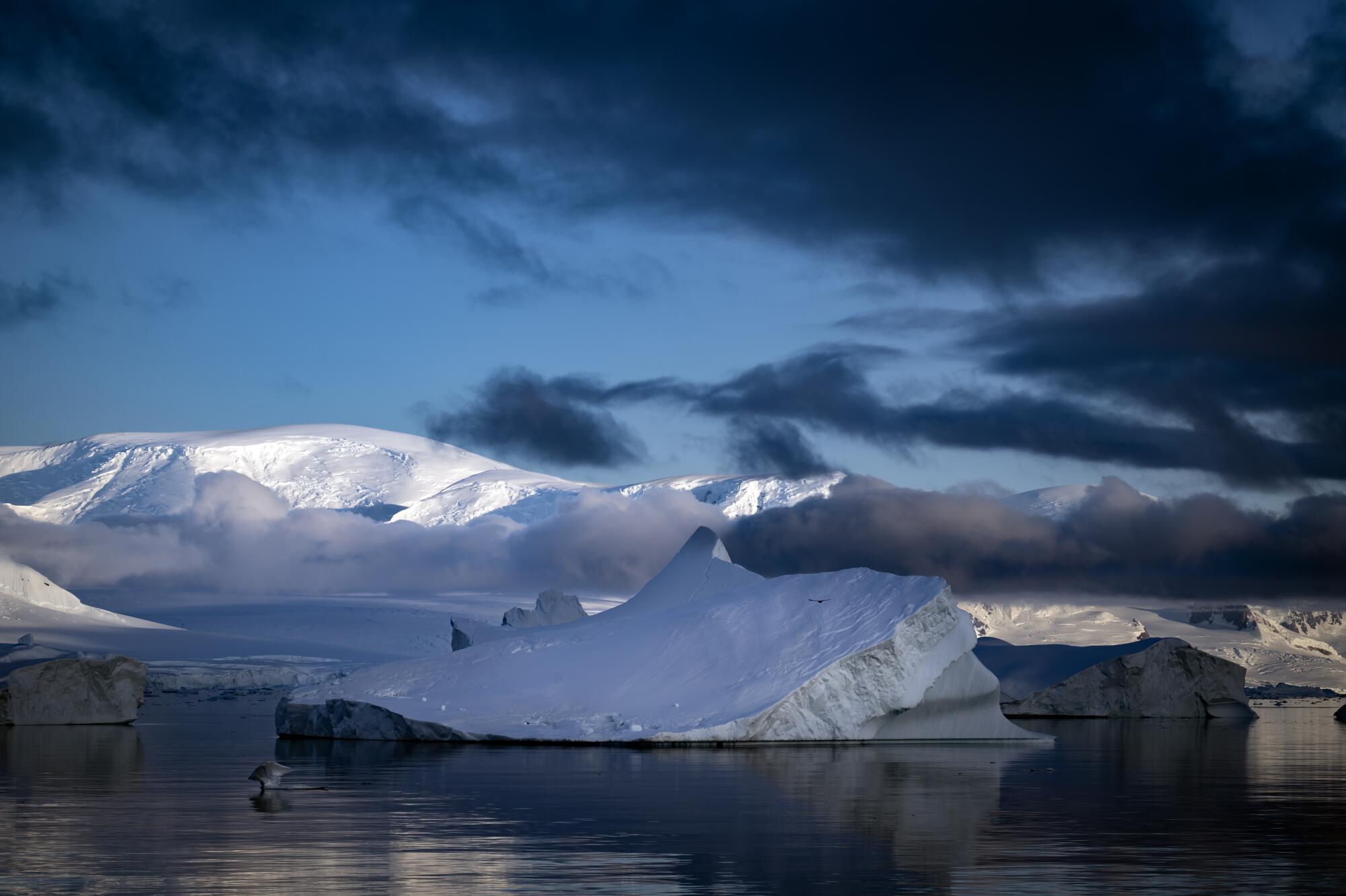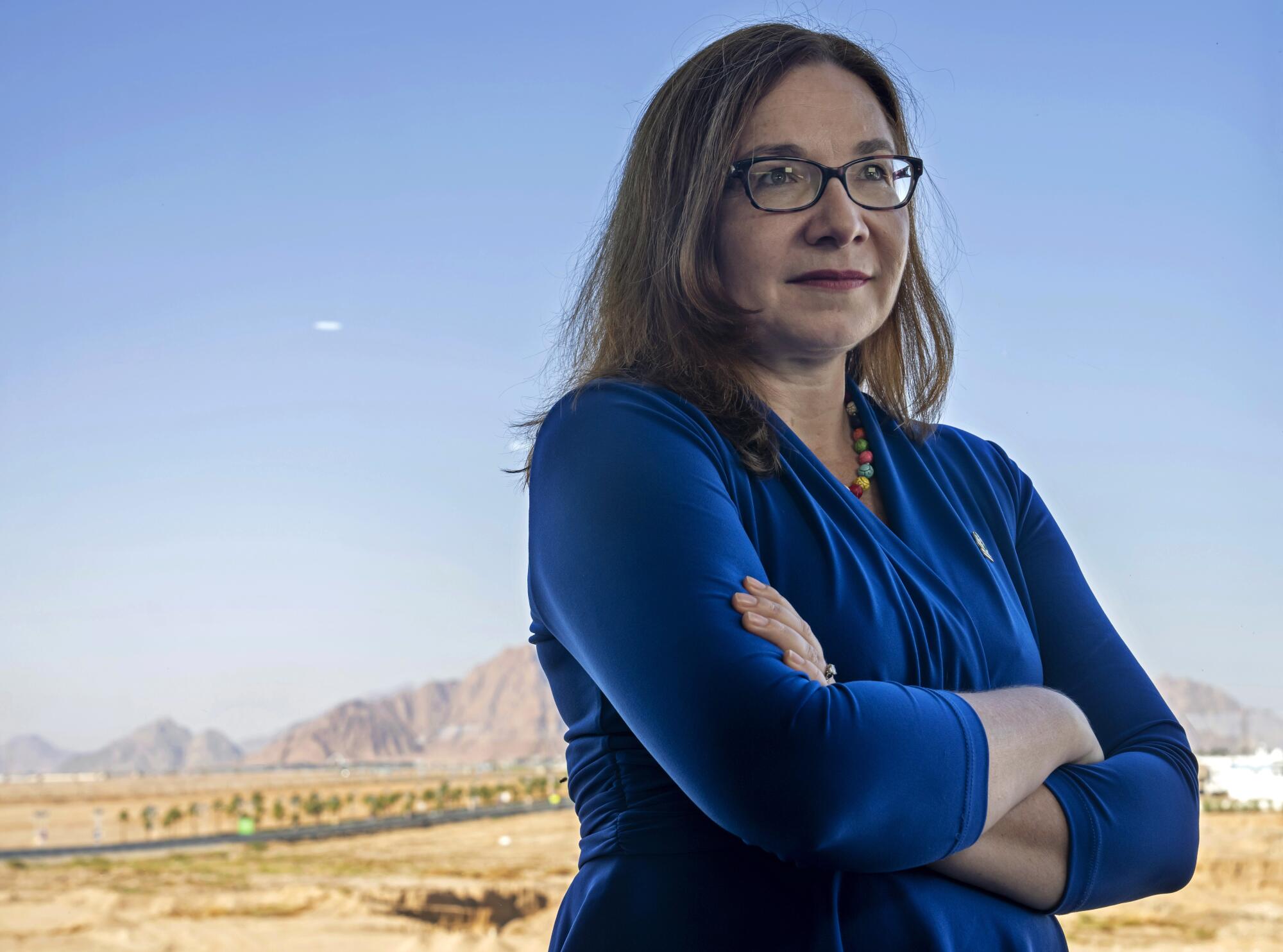Peter Neff understands the allure of the world’s fifth largest continent.
His phone camera is full of videos and photos of his trips to Antarctica Glacologist and climate scientist He has spent days and weeks collecting ice core samples. His work helps create a record of past weather conditions and predict what will come in the future.
When pandemic quarantines began and kept everyone at home, Neff, a professor at the University of Minnesota, increased her social media presence by posting descriptions of her work online under the username. “Ice Pete.” He reposted a video on TikTok that did well on X, which captures the video It makes the sound of a piece of ice When it falls 90 meters from the well (“Pew!” just like the sound of gunshots in a cartoon). It was an instant hit, garnering over 30,000 views.

A view of a steep iceberg in Antarctica in February. Scientists like glaciologist Peter Neff focus on mapping changes in Antarctica’s glaciers and ice sheets.
(Sabnam Kuskun/Anadolu/Getty Images)
In 2024 (and 2022), Neff as a A weather maker to watcha collaboration between media startup Pique Action and Harvard School of Public Health’s T. Chan, and his posts have garnered more than 4 million likes.
“As a scientist, my job is to tell people what the situation is and what we can do to make it better or not worse,” Neff said in an interview. “I hope I can provide information that can be used to accurately describe the challenges we face, because they are quite serious.”
As the Internet accommodates an ever-increasing range of voices, scientists studying climate and the environment are sharing their work online, translating obscure topics and discoveries into accessible information. they do Instead of waiting years for their studies and work to be published in academic journals, scientists like Neff have used social media to expand their reach and brand.
Joe Hansona biologist who hosts PBS “be smart” Seri is a well-known voice on climate issues on YouTube. A 44 second video that explains Keeling curve (daily record of carbon dioxide concentration in the global atmosphere) has 2.4 million views. he 28 minute video Confronting Climate Change Myths has been viewed over 900,000 times. Climate scientist Kathryn Heyhoe It has an established presence on Instagram and partners with influencers to spread the climate science gospel. Peter Calmus In 2022 when he and other scientists hit the Internet He chained himself to the door from the JP Morgan Chase office building in downtown Los Angeles to protest the company’s fossil fuel investments and were subsequently arrested. On X, his ClimateHuman account has over 330,000 followers.
The potential to attract likes is huge. according to to the Pew Research CenterA survey found that about half of US adults said they at least “sometimes” saw news while using social media platforms.
Neff has studied glaciology for 15 years, and has been to the Antarctic region several times to study ice cores — hollow cylinders of ice that serve as a record of past climate change — extracted from ice sheets and glaciers. can – has traveled Among his many titles, he is the director of field research and data for the organization The center of the oldest ice discovery

Catherine Hayhoe at the COP27 United Nations Climate Summit in Sharm el-Sheikh, Egypt, in 2022. Hayhoe has an established presence on Instagram and partners with influencers to share climate science.
(Nariman Al-Mufti/Associated Press)
On TikTok, Neff explains the process “How to go from old air in ice to sample air” In 60 seconds, while an academic journal entry might have more scientific jargon and explanation, Neff breaks down his process of working with ice cores in layman’s terms and rushes through the narrative—“Gale drills his ice core. do”, ‘load ice into vacuum chamber,’ ‘melting ice’ – with real audio for a video that has over 617,000 views as of this writing.
Neff’s TikTok account had 224,000 followers, and a graduate student and fellow Antarctic scientist, Austin Carter He also posts about his work through the Oldest Ice Discovery Center, which has garnered him nearly 254,000 followers.
According to a study published in January by The Center for Countering Digital Hate A British non-profit that monitors online hate speech, climate denial has shifted from global warming denial to claims that climate solutions don’t work and that the climate movement is untrustworthy across platforms. (The study, which analyzed about 12,000 videos using artificial intelligence, also found that YouTube compensates 13.4 million dollars “From channels that deny posting.”)
Neff has some nasty words for climate deniers. At one point, he deleted a video showing solar halos in Antarctica because it had gone viral among “flat earthers” who tried to use the video as proof that the world is not, in fact, round.
“These people are brick walls … and you’re not going to change anyone’s mind,” he said. “You never know what people are going to do with your content when you post it.”
Climatologist emphasizes the role scientists can play in disseminating fact-based information.
“I’m just trying to educate people … especially when everything we do is funded by public funds,” Neff said. “We have an obligation to share about it.”
Ayanna Elizabeth Johnsona marine biologist, took a different route to social media stardom. He is based as the former executive director of La Jolla Witt InstituteImplementing sustainable ocean policies and programs, she led outreach efforts to ensure Barbudan fishing communities were involved in policy proposals. He began setting up Facebook pages for the effort and realized he had a knack for communicating his work to the public. He then began blogging for National Geographic and writing freelance stories.

Marine biologist Ayanna Elizabeth Johnson speaks on stage during the 2019 NYC Climate Strike rally and demonstration in Battery Park.
(Ron Adar / SOPA Images / SOPA USA / Associated Press)
“To me, all climate and environmental communication is about how we can replicate each other’s successes and avoid others’ failures,” says Johnson, who has studied marine biology for about 12 years. “So it’s about getting into the weeds a little bit, hopefully, in a way that’s attractive and pleasant rather than like, boring and unbearable.”
Johnson has earned his expertise through many endeavors. He is a Rooks Distinguished Scholar at Bowdoin College, a co-founder of the think tank. Urban Ocean Laboratory and The We Can Save Project which both promote sustainable marine and climate solutions. This month, Johnson released his book, What If We Do It Right? That includes conversations with farmers, climate activists, and financiers—among others—in an effort to map out possible climate futures. In addition, he appears in several publications and platforms to convince the public that there is still hope to prevent climate catastrophe.
On TikTok, where he doesn’t have an account, a clip from one of his Ted talks with five people Facts about parrot fish It has more than 400,000 views. Johnson is often featured on podcasts as a guest to talk about ocean conservation and shares her followers. Venn diagram of climate action To inspire action and defeat despair.
In 2020, he gained a large following after being published by the Washington Post op-ed which confronted climate policies and racism. The content he posts under his own name is personal and conversational (he has over 120,000 followers on Instagram), but the organizations he runs stick to policy-oriented posts.
Conversations between people, scientists and policymakers are all part of working toward a climate solution, Johnson said. “That’s really at the heart of the way I try to share information, it’s not that I’m there, it’s not just like shouting into a void as an individual, but trying to make this a collective conversation.”
For now, Johnson said he will continue his “disturbing” relationship with social media and continue to be a voice people can turn to on climate policy ahead of November’s presidential election and even local races that could affect They directly trust it. on voters
“There’s a great oblivion in the United States about the Trump administration, and how terrible it was for the environment,” he said, citing the hundreds of clean air and water environmental laws he backed. I really want to do my small part in helping people understand how to choose a climate voter. People who follow me care about this, but it’s really hard to get good information from someone you trust.
#Scientists #source #hope #information #TikTok #Instagram
